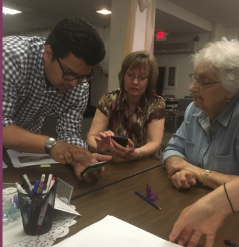 Germán demonstrates a smartphone task in person
Germán demonstrates a smartphone task in person
To the millennial generation in the United States, using current technology is second nature. We hardly think twice about the steps we take to send an email, conduct a Google search or share a picture to Instagram. But to people who didn’t grow up with computers and smartphones, using technology can be a daunting and confusing experience. This lack of access to and knowledge about technology is known as the “digital divide” and is an issue that ESTEEM graduates from the Class of 2017, Eva-Marie Costello and Germán Estrada, have decided to tackle.
Eva-Marie was first introduced to the seriousness of the problem after founding a non-profit in India. She started to see that when the people she was working with received access to devices like smartphones, it didn’t necessarily mean that they were able to use the devices to be productive, rather than just social. “They would contact me via WhatsApp to ask me to Google information about banking and other services,” she says. “They didn’t understand how to use the internet to find this information on their own.”
This lack of understanding surrounding devices is not only relevant in countries like India. Although the U.S. has 98% Internet penetration and 77% smartphone usage, there is still a huge digital usability divide throughout the country. Eva-Marie further explored the problem after being accepted into the inaugural cohort of the Venture Founders Program while at ESTEEM. Specifically, she looked at what happens when you give someone a device – and how they take advantage of it.
Eva-Marie explains, "From our research, we noticed that when a person gets access to a new tech device there are three distinct layers: 1. Awareness, 2. Trust, and 3. Confidence. Instead of solving them all at once, we believe the key to behavioral change is tackling these layers individually – and that's what we aim to do."
 Eva-Marie and a group of MartyHow testers
Eva-Marie and a group of MartyHow testers
After graduating from ESTEEM, Eva-Marie teamed up with Germán Estrada, and along with help from former classmate Ralf Hayyat, they set out use the lessons in entrepreneurship that they learned in ESTEEM to find a solution to the digital divide. Starting with validating the problem, the team has spent over 3 months with numerous organizations in South Bend, Indiana, talking to people aged 50 years and older about the barriers they have with trusting technology.
“We see a huge opportunity to unlock this segment’s ability to start interacting with the digital world to improve multiple aspects of their lives, including social, health and financial,” says Eva-Marie. The team used insights from the time they’ve spent talking with people along with advice from behavioral scientists to create a unique product that has a combination of both videos and infographics. Eva-Marie and Germán are currently focusing on testing their solution, which they call MartyHow, that helps people to better understand and complete tasks on their smartphones.
Ultimately, Eva-Marie and Germán want to change people’s experience with technology from one of fear to one of excitement. In addition to helping people feel capable and confident in using digital devices, Eva-Marie says, “we also want to equip people with the skills to make mindful decisions in the digital world regarding privacy and finances.” That’s why along with teaching people how to add and use smart phone apps, they also teach individuals how to delete applications and remove their personal information, ensuring that people have the ability to make informed choices about what technology to use.
While MartyHow is currently focusing on smart phones, as technology continues to rapidly advance, Eva-Marie and Germán want to continue to build trust between users and whatever the next big device will be, whether it’s a connected home device, VR experience, or self-driving car.
 A MartyHow focus group
A MartyHow focus group
Next, Eva-Marie is headed to San Francisco, California to create awareness of the problem of the digital divide, to share the insights she’s discovered during problem validation, and to work on gaining more MartyHow supporters as team members and investors.
To keep track of MartyHow’s progress, check out their website and follow them on Facebook!
In addition, if you or anyone you know would be interested in being a potential tester for MartyHow, or if you would like to get involved with Eva-Marie and Germán’s quest to help people navigate the digital world, please email Eva-Marie directly at evamariecos@gmail.com.